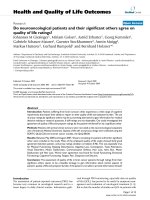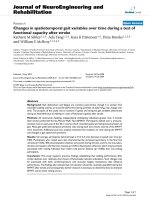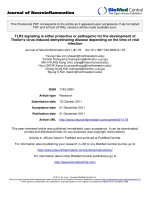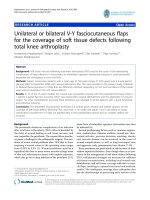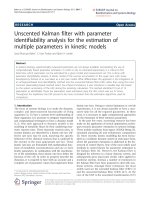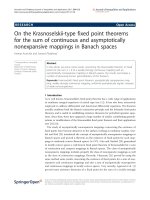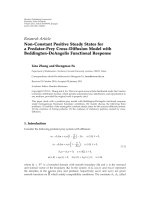Báo cáo hóa học: " PICARD ITERATION CONVERGES FASTER THAN MANN ITERATION FOR A CLASS OF QUASI-CONTRACTIVE OPERATORS" pdf
Bạn đang xem bản rút gọn của tài liệu. Xem và tải ngay bản đầy đủ của tài liệu tại đây (497.26 KB, 9 trang )
PICARD ITERATION CONVERGES FASTER
THAN MANN ITERATION FOR A CLASS
OF QUASI-CONTRACTIVE OPERATORS
VASILE BERINDE
Received 20 November 2003 and in revised form 6 February 2004
In the class of quasi-contractive operators satisfying Zamfirescu’s conditions, the most
used fixed point iterative methods, that is, the Picard, Mann, and Ishikawa iterations, are
all known to be convergent to the unique fixed point. In this paper, the comparison of the
first two methods with respect to their convergence rate is obtained.
1. Introduction
In the last three decades many papers have been published on the iterative approxima-
tion of fixed points for certain classes of operators, using the Mann and Ishikawa iteration
methods, see [4], for a recent survey. These papers were motivated by the fact that, un-
der weaker contractive type conditions, the Picard iteration (or the method of successive
approximations), need not converge to the fixed point of the operator in question.
However, there exist large classes of operators, as for example that of quasi-contractive
type operators introduced in [4, 7, 10, 11], for which not only the Picard iteration, but
also the Mann and Ishikawa iterations can be used to approximate the fixed points. In
such situations, it is of theoretical and practical importance to compare these methods in
order to establish, if possible, which one converges faster.
As far as we know, there are only a few papers devoted to this very important numer-
ical problem: the one due to Rhoades [11], in which the Mann and Ishikawa iterations
are compared for the class of continuous and nondecreasing functions f : [0, 1]
→ [0,1],
and also the author’s papers [1, 3, 5], concerning the Picard and Krasnoselskij iterative
procedures in the class of Lipschitzian and generalized pseudocontractive operators.
An empirical comparison of Newton, Mann, and Ishikawa iterations over two families
of decreasing functions was also reported in [13]. In [4] some conclusions of an empir-
ical numerical study of Krasnoselskij, Mann, and Ishikawa iterations for some Lipschitz
strongly pseudocontractive mappings, for which the Picard iteration does not converge,
were also presented.
Copyright © 2004 Hindawi Publishing Corporation
Fixed Point Theory and Applications 2004:2 (2004) 97–105
2000 Mathematics Subject Classification: 47H10, 54H25
URL: />98 Picard iteration converges faster than Mann iteration
It is the main purpose of this paper to compare the Picard and Mann iterations over
a class of quasi-contractive mappings, that is, the ones satisfying the Zamfirescu’s con-
ditions [15]. Theorem 3.1 in the present paper shows that for the aforementioned class
of operators, considered in uniformly convex Banach spaces, the Picard iteration always
converges faster than the Mann iterative procedure. Moreover, Theorem 3.3 extends this
result to arbitrary Banach spaces and also to Mann iterations defined by weaker assump-
tions on the sequence {α
n
}.
2. Some fixed point iteration procedures
Let E be a normed linear space and T : E → E a given operator. Let x
0
∈ E be arbitrary
and {α
n
}⊂[0,1] a sequence of real numbers. The sequence {x
n
}
∞
n=0
⊂ E defined by
x
n+1
=
1 − α
n
x
n
+ α
n
Tx
n
, n = 0,1,2, , (2.1)
is called the Mann iteration or Mann iterative procedure.
The sequence {x
n
}
∞
n=0
⊂ E defined by
x
n+1
=
1 − α
n
x
n
+ α
n
Ty
n
, n = 0,1, 2, ,
y
n
=
1 − β
n
x
n
+ β
n
Tx
n
, n = 0,1,2, ,
(2.2)
where
{α
n
} and {β
n
} are sequences of positive numbers in [0,1], and x
0
∈ E is arbitrary,
is called the Ishikawa iteration or Ishikawa i terative procedure.
Remarks 2.1. For α
n
= λ (constant), the iteration (2.1) reduces to the so-called Krasnosel-
skij iteration while for α
n
≡ 1weobtainthePicard iteration (2.3), or the method of suc-
cessive approximations, as it is commonly known. Obviously, for β
n
≡ 0 the Ishikawa
iteration (2.2)reducesto(2.1).
Example 2.2 [4]. Let K = [1/2,2] ⊂ R be endowed with the usual norm and T : K → K,
defined by Tx = 1/x, x ∈ K.Then,
(1) T has a unique fixed point, that is, F
T
={1};
(2) the Picard iteration (2.3)doesnotconvergeto1,foranyx
0
= 1in[1/2,2];
(3) the Krasnoselskij iteration converges to the fixed point of T,forλ satisfying 0 <λ<
2(1 − r)/(17 − 2r), where 0 <r<1.
It is well known that the Krasnoselskij, Mann, and Ishikawa iterative procedures have
been int roduced mainly in order to approximate fixed points of those operators for which
the Picard iteration does not converge. But, as we already mentioned, there exist impor-
tant classes of contractive mappings, that is, the class of quasi-contractions, for which all
Picard, Krasnoselskij, Mann, and Ishikawa iterations converge. The next two theorems
refer to the Picard and Mann iterations.
Vasile Berinde 99
Theorem 2.3 [15]. Let (X,d) be a complete metric space and T : X → X a map for which
there exist the real numbers a, b,andc satisfying 0 <a<1, 0 <b, c<1/2 such that for each
pair x, y in X,atleastoneofthefollowingistrue:
(z
1
) d(Tx,Ty) ≤ ad(x, y);
(z
2
) d(Tx,Ty) ≤ b[ d(x,Tx)+d(y, Ty)];
(z
3
) d(Tx,Ty) ≤ c[d(x,Ty)+d(y,Tx)].
Then T has a unique fixed point p and the Picard iteration {x
n
}
∞
n=0
defined by
x
n+1
= Tx
n
, n = 0,1, 2, , (2.3)
converges to p,foranyx
0
∈ X.
Theorem 2.4 [10]. Let E be a uniformly convex Banach space, K a closed convex subset of
E,andT : K → K a Zamfirescu mapping. Then the Mann iteration {x
n
} given by (2.1)with
{α
n
} satisfying the conditions
(i) α
1
= 1;
(ii) 0 ≤ α
n
< 1 for n>1;
(iii)
α
n
(1 − α
n
) =∞;
converges to the fixed point of T.
In order to compare two fixed point iteration procedures {u
n
}
∞
n=0
and {v
n
}
∞
n=0
that
converge to a certain fixed point p of a given operator T,Rhoades[11] considered that
{u
n
} is better than {v
n
} if
u
n
− p
≤
v
n
− p
, ∀n. (2.4)
In the following we will adopt the terminology from our papers [3, 4, 5], which is slightly
different from that of Rhoades, but more suitable for our purposes here.
Definit ion 2.5. Let
{a
n
}
∞
n=0
, {b
n
}
∞
n=0
be two sequences of real numbers that converge to a
and b, respectively, and assume that there exists
l = lim
n→∞
a
n
− a
b
n
− b
. (2.5)
(a) If l = 0, then it can be said that {a
n
}
∞
n=0
converges faster to a than {b
n
}
∞
n=0
to b.
(b) If 0 <l<∞, then it can be said that {a
n
}
∞
n=0
and {b
n
}
∞
n=0
have the same rate of
convergence.
Remarks 2.6. (1) In the case (a) we use the notation a
n
− a = o(b
n
− b).
(2) If l =∞, then the sequence {b
n
}
∞
n=0
converges faster than {a
n
}
∞
n=0
,thatis
b
n
− b = o
a
n
− a
. (2.6)
100 Picard iteration converges faster than Mann iteration
Suppose that for two fixed point iteration procedures {u
n
}
∞
n=0
and {v
n
}
∞
n=0
, both converg-
ing to the same fixed point p, the error estimates
u
n
− p
≤ a
n
, n = 0,1, 2, , (2.7)
v
n
− p
≤ b
n
, n = 0,1, 2, , (2.8)
are available, where {a
n
}
∞
n=0
and {b
n
}
∞
n=0
are two sequences of positive numbers (con-
verging to z ero).
Then,inviewofDefinition 2.5, we will adopt the follow ing concept.
Definit ion 2.7. Let {u
n
}
∞
n=0
and {v
n
}
∞
n=0
be two fixed point iteration procedures that con-
verge to the same fixed point p and satisfy (2.7)and(2.8), respectively. If {a
n
}
∞
n=0
con-
verges faster than {b
n
}
∞
n=0
, then it can be said that {u
n
}
∞
n=0
converges faster than {v
n
}
∞
n=0
to p.
Example 2.8. If we take p = 0, u
n
= 1/(n +1), v
n
= 1/n, n ≥ 1, then {u
n
} is better than
{v
n
},but{u
n
} does not converge faster than {v
n
}. Indeed, we have
lim
n→∞
u
n
v
n
= 1, (2.9)
and hence {u
n
} and {v
n
} havethesamerateofconvergence.
The previous example shows that Definition 2.7 introduces a sharper concept of rate
of convergence than the one considered by Rhoades [11].
Using Theorems 2.3 and 2.4 and based on Definition 2.7, the next section compares
the Picard and Mann iterations in the class of Zamfirescu operators. The conclusion will
be that the Picard iteration always converges faster than the Mann iteration, as was ob-
served empirically on some numerical tests in [4].
3. Comparing Picard and Mann iterations
Themainresultofthispaperisgivenbythenexttheorem.
Theorem 3.1. Let E be a uniformly convex Banach space, K a closed convex subset of E,and
T : K
→ K a Zamfirescu operator; that is, an operator that satisfies (z
1
), (z
2
), and (z
3
). Let
{x
n
}
∞
n=0
be the Picard iteration associated with T,startingfromx
0
∈ K,givenby(2.3), and
{y
n
}
∞
n=0
the Mann iteration given by (2.1), where {α
n
}
∞
n=0
is a sequence satisfying
(i) α
1
= 1;
(ii) 0 ≤ α
n
< 1 for n ≥ 1;
(iii)
∞
n=0
α
n
(1 − α
n
) =∞.
Then,
(1) T has a unique fixed point in E, that is, F
T
={p};
(2) the Picard iteration {x
n
} converges to p for any x
0
∈ K;
(3) the Mann iteration {y
n
} converges to p for any y
0
∈ K and {α
n
} satisfying (i), (ii),
and (iii);
(4) Picard iteration is faste r than any Mann iteration.
Vasile Berinde 101
Proof. Conclusions (1), (2), and (3) follow by Theorems 2.3 and 2.4.
(4) First of all, we prove that any Zamfirescu operator satisfies
Tx− Ty≤δ ·x − y +2δ ·x − Tx, (3.1)
Tx− Ty≤δ ·x − y +2δ ·y − Tx, (3.2)
for all x, y ∈ K,whereδ is given by (3.6).
Indeed, choose x, y ∈ K. Then at least one of (z
1
), (z
2
), or (z
3
)istrue.If(z
1
) is satisfied,
then (3.1)and(3.2) obviously hold with δ = a.
If (z
2
)holds,then
Tx− Ty≤b
x − Tx + y − Ty
≤ b
x − Tx +
y − x + x − Tx + Tx− Ty
,
(3.3)
which yields
Tx− Ty≤
b
1 − b
x − y +
2b
1 − b
x − Tx. (3.4)
If (z
3
) holds, then we similarly get
Tx− Ty≤
c
1 − c
x − y +
2c
1 − c
x − Tx. (3.5)
Therefore, by denoting
δ = max
a,
b
1 − b
,
c
1 − c
, (3.6)
then in view of the assumptions 0 ≤ a<1; 0 ≤ b<1/2; 0 ≤ c<1/2 it follows that 0 ≤ δ<1
and so, for all x, y ∈ K, inequality (3.1) is true. Inequality (3.2) is obtained similarly.
Taki ng y := x
n
; x := p in (3.1), we obtain
x
n+1
− p
≤ δ ·
x
n
− p
, (3.7)
which inductively yields
x
n+1
− p
≤ δ
n
·
x
1
− p
, n ≥ 0. (3.8)
Now let y
0
∈ K and let {y
n
}
∞
n=0
be the Mann iteration associated with T, y
0
, and the
sequence {α
n
}.Thenby(2.1)wehave
y
n+1
− p
=
1 − α
n
y
n
+ α
n
Ty
n
−
1 − α
n
+ α
n
p
≤
1 − α
n
y
n
− p
+ α
n
Ty
n
− p
.
(3.9)
Using (3.2)withy := y
n
, x := p,weget
Ty
n
− p
≤ δ ·
y
n
− p
+2δ
y
n
− p
=
3δ
y
n
− p
(3.10)
and therefore
y
n+1
− p
≤
1 − α
n
+3δα
n
·
y
n
− p
, n = 0,1, 2, , (3.11)
102 Picard iteration converges faster than Mann iteration
which implies that
y
n+1
− p
≤
n
k=1
1 − α
k
+3δα
k
·
y
1
− p
, n = 0,1, 2, (3.12)
In order to compare {x
n
} and {y
n
},wemustcompareδ
n
and
n
k=1
(1 − α
k
+3δα
k
).
First, note that 1 − α
k
+3δα
k
> 0, for all δ ∈ [0,1) and {α
k
}
∞
k=1
satisfying (ii). Moreover,
if δ ∈ [0,1/3), then
1 − α
k
+3δα
k
< 1, (3.13)
while for δ ∈ [1/3,1) we have
1 − α
k
+3δα
k
≥ 1. (3.14)
Thus, for δ ∈ [1/3,1) we have
0 ≤ lim
n→∞
δ
n
n
k=1
1 − α
k
+3δα
k
≤ lim
n→∞
δ
n
= 0, (3.15)
which shows that, in this case, the Picard iteration converges faster than the Mann
iteration.
If δ ∈ [0,1/3), then it is easy to verify that, for any {α
k
}⊂[0,1],
α
k
≤ 1 <
1 − 2δ
3δ
2
− 4δ +1
, (3.16)
which yields
δ
1 − α
k
+3δα
k
< 1 − δ. (3.17)
Hence
δ
n
n
k=1
1 − α
k
+3δα
k
< (1 − δ)
n
, ∀n ≥ 1, (3.18)
and therefore
lim
n→∞
δ
n
n
k=1
1 − α
k
+3δα
k
=
0. (3.19)
This shows that the Picard iteration converges faster than the Mann iteration for δ ∈
[0,1/3).
Remarks 3.2. (1) Theorem 3.1 shows that, to efficiently approximate fixed points of Zam-
firescu operators, one should always use the Picard iteration.
(2) Since strict contractions, Kannan mappings [9], Hardy and Rogers generalized
contractions [8], as well as Chatterjea mappings [6] belong to the class of Zamfirescu
operators, by Theorem 3.1, we obtain similar results for these classes of contractive map-
pings.
Vasile Berinde 103
(3) Some numerical tests perform ed with the aid of the software package fixpoint [4]
raise the following open problem: for the class of Zamfirescu operators, does the Mann
iteration converge faster than the Ishikawa iteration?
(4) The uniform convexity of E is not necessary for the conclusion of Theorem 2.4 to
hold. (See [2], where the author extended Theorem 2.4 to arbitrary Banach spaces and
also to Mann iterations defined by weaker assumptions on the sequence {α
n
}.)
The following question then naturally ar ises: is conclusion (4) in Theorem 3.1 still
valid under these weaker hypotheses?
A positive answer is provided by the next theorem.
Theorem 3.3. Let E be an arbitrary Banach space, K a closed convex subset of E,and
T : K → K an operator satisfying Zamfirescu’s conditions. Let {y
n
}
∞
n=0
be defined by (2.1)
and y
0
∈ K,with{α
n
}⊂[0,1] satisfying
(iv)
∞
n=0
α
n
=∞.
Then
{y
n
}
∞
n=0
convergesstronglytothefixedpointofT and, moreover, the Picard iteration
{x
n
}
∞
n=0
defined by (2.3)andx
0
∈ K converges faster than the Mann iteration.
Proof. Similar to the proof of Theorem 3.1 we get
y
n+1
− p
≤
1 − α
n
y
n
− p
+ α
n
Ty
n
− p
. (3.20)
Take x := p and y := y
n
in (3.1)toobtain
Ty
n
− p
≤ δ ·
y
n
− p
, (3.21)
and then
y
n+1
− p
≤
1 − (1 − δ)α
n
y
n
− p
, n = 0,1, 2, (3.22)
By induction, we get
y
n+1
− p
≤
n
k=0
1 − (1 − δ)α
k
·
y
0
− p
, n = 0,1, 2, (3.23)
As δ<1, α
k
∈ [0, 1], and
∞
k=0
α
k
=∞, it follows that
lim
n→∞
n
k=0
1 − (1 − δ)α
k
=
0, (3.24)
which by (3.23) implies that
lim
n→∞
y
n+1
− p
=
0, (3.25)
that is, {y
n
}
∞
n=0
converges strongly t o p.
The proof of the second part of the theorem is similar to that of Theorem 3.1.
104 Picard iteration converges faster than Mann iteration
Remarks 3.4. (1) Condition (iv) in Theorem 3.3 is weaker than conditions (i), (ii), and
(iii) in Theorems 2.4 and 3.1. Indeed, in view of the inequality
0 <α
k
1 − α
k
<α
k
, (3.26)
valid for all α
k
satisfying (i) and (ii), condition (iii) implies (iv).
There also exist values of {α
n
},forexample,α
n
≡ 1, such that (iv) is satisfied, but (iii)
is not.
(2) The main merit of this paper consists not only in the results given by Theorems 3.1
and 3.3, but also in the fact that these theoretical results were suggested by some empirical
tests on contractive-type operators, s ee [4,Chapter9].
(3) The class of mappings T satisfying Zamfirescu’s conditions coincides (see [12])
with the class of operators for which there exists a real number 0 <h<1suchthat
d(Tx,Ty)
≤ h max
d(x, y),
d(x,Tx)+d(y,Ty)
2
,
d(x,Ty)+d(y,Tx)
2
, (3.27)
so, our results are valid for all fixed point theorems obtained for these operators as well.
(4) For the larger class of quasi-contractions introduced by
´
Ciri
´
c[7], both Picard [7]
and Mann [10] (and also Ishikawa [14]) iterations are known to converge to the unique
fixed point. It remains to answer the natural question whether or not Picard iteration
converges faster than the Mann iteration for this class of mappings.
Acknowledgment
The author would like to thank one of the anonymous referees for his helpful comments
and some stylistic changes suggested, as well as for pointing to reference [8].
References
[1] V. Berinde, Comparing Krasnoselskij and Mann iterations for Lipschitzian generalized pseudocon-
tractive operators, Proc. Int. Conf. Fixed Point Theory and Applications (Valencia, 2003),
Yokohama Publishers, Yokohama, in press.
[2]
, On the convergence of Mann iteration for a class of quasi contractive operators, in prepa-
ration.
[3]
, Approximating fixed points of Lipschitzian generalized pseudo-contractions,Mathemat-
ics & Mathematics Education (Bethlehem, 2000), World Scientific Publishing, New Jersey,
2002, pp. 73–81.
[4]
, Iterative Approximation of Fixed Points, Editura Efemeride, Baia Mare, 2002.
[5] , Iterative approximation of fixed points for pseudo-contractive operators, Semin. Fixed
Point Theory Cluj-Napoca 3 (2002), 209–215.
[6] S.K.Chatterjea,Fixed-point theorems, C. R. Acad. Bulgare Sci. 25 (1972), 727–730.
[7] Lj. B.
´
Ciri
´
c, A generalization of Banach’s contraction principle,Proc.Amer.Math.Soc.45 (1974),
267–273.
[8] G.E.HardyandT.D.Rogers,A generalization of a fixed point theorem of Reich, Canad. Math.
Bull. 16 (1973), no. 2, 201–206.
[9] R. Kannan, Some results on fixed points, Bull. Calcutta Math. Soc. 60 (1968), 71–76.
[10] B. E. Rhoades, Fixed point iterations using infinite matrices, Trans. Amer. Math. Soc. 196 (1974),
161–176.
Vasile Berinde 105
[11] , Comments on two fixed point iteration methods,J.Math.Anal.Appl.56 (1976), no. 3,
741–750.
[12] , A comparison of various definitions of contractive mappings, Trans. Amer. Math. Soc.
226 (1977), 257–290.
[13] , Fixed point iterations using infinite matrices. III, Fixed Points: Algorithms and Appli-
cations (Proc. First Internat. Conf., Clemson Univ., Clemson, SC, 1974), Academic Press,
New York, 1977, pp. 337–347.
[14] H. K. Xu, A note on the Ishikawa iteration scheme, J. Math. Anal. Appl. 167 (1992), no. 2, 582–
587.
[15] T. Zamfirescu, Fix point theorems in metric spaces,Arch.Math.(Basel)23 (1972), 292–298.
Vasile Berinde: Department of Mathematics and Computer Science, North University of Baia
Mare, Victorie 76, 430072 Baia Mare, Romania
E-mail address:


